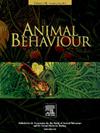Growing up with nutritional stress leads to peripheral social network positions, independent of ‘personality’
IF 2.3
2区 生物学
Q2 BEHAVIORAL SCIENCES
引用次数: 0
Abstract
Social integration predicts life span in gregarious species, including humans, but the causes of variation in social integration and its link to behaviour (‘personality’) in other domains are not well known. Early life conditions also shape fitness variation, possibly through effects on personality and social integration. We studied social integration in zebra finches, Taeniopygia castanotis, reared with different levels of nutritional stress, which we showed to affect offspring growth and thereby fitness prospects. Growing up with nutritional stress caused individuals to attain more peripheral positions in social networks, as they interacted (1) with fewer individuals, (2) less frequently with their connections and (3) less with well-connected (i.e. ‘popular’) individuals. Thus early-life adversity effects on social integration may mediate effects on fitness. In contrast, behaviour in five standardized tests was independent of early life adversity, and consistent with these findings, behavioural scores were at most weakly predictive of network position. Choice of interaction partner did, however, depend on personality, with individuals interacting assortatively with respect to gregariousness and disassortatively with respect to boldness. Thus, developmental conditions may affect fitness prospects through effects on social integration, independent of ‘personality’, and suggest that some level of (social) challenge is required to reveal carry-over effects of early development.
在营养紧张的环境下长大,会导致他们在社会网络中的地位处于边缘,与“个性”无关。
社会整合预测了包括人类在内的群居物种的寿命,但社会整合变化的原因及其与其他领域行为(“个性”)的联系尚不清楚。早期生活条件也会影响健康的变化,可能是通过对个性和社会融合的影响。我们研究了在不同营养应激水平下饲养的斑胸草雀(Taeniopygia castanotis)的社会整合,发现营养应激水平会影响后代的生长,从而影响其适应性前景。在营养压力下成长导致个体在社会网络中获得更多的边缘位置,因为他们(1)与更少的个体互动,(2)与他们的联系更少,(3)与关系良好(即“受欢迎”)的个体互动更少。因此,早期生活逆境对社会整合的影响可能会介导对健康的影响。相比之下,五项标准化测试中的行为与早期生活逆境无关,与这些发现一致,行为得分最多只能微弱地预测网络位置。然而,互动伙伴的选择确实取决于个性,个体在合群方面的选择是与之匹配的,而在大胆方面的选择是与之不匹配的。因此,发展条件可能通过对社会整合的影响来影响健康前景,独立于“个性”,并表明需要一定程度的(社会)挑战来揭示早期发展的遗留效应。
本文章由计算机程序翻译,如有差异,请以英文原文为准。
求助全文
约1分钟内获得全文
求助全文
来源期刊

Animal Behaviour
生物-动物学
CiteScore
4.60
自引率
8.00%
发文量
236
审稿时长
10.2 weeks
期刊介绍:
Growing interest in behavioural biology and the international reputation of Animal Behaviour prompted an expansion to monthly publication in 1989. Animal Behaviour continues to be the journal of choice for biologists, ethologists, psychologists, physiologists, and veterinarians with an interest in the subject.
 求助内容:
求助内容: 应助结果提醒方式:
应助结果提醒方式:


